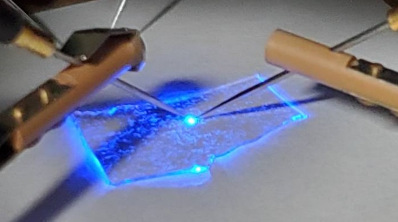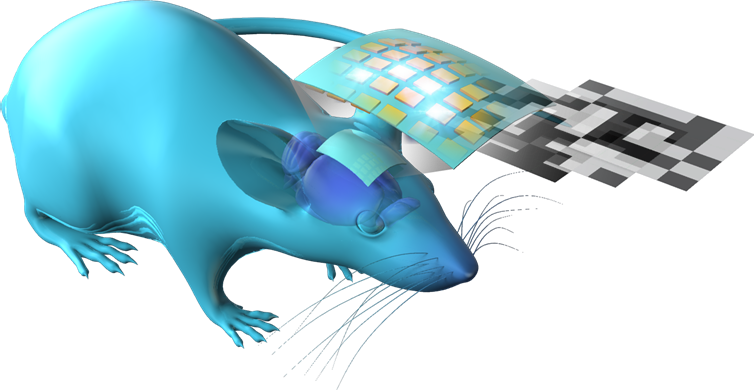Research Outline
Light bulbs and fluorescent lights have started to change to LED lights, and LEDs have become a familiar part of our lives. Recently, attention has been paid to the integration technology of small LEDs, which are 1/10, 1/100 or less than the conventional LEDs called “Micro LEDs”. “Micro LEDs” are expected to be applied to a wide range of field such as high-brightness/high-definition display, illumination and indicator of automobile for safety, smart fibers, optical transmission using plastic fibers and spatial optical communication (Li-Fi), underwater communication technology, and bio-applications. In our laboratory, we are conducting research with a focus on application to brain science and next-generation display using “Micro LED”.
Theme 1: Development of Needle-type Micro LED/Neural Electrode Probe
We are developing tools to measure neural activity in the cerebral cortex. Until now, control of nerve activity has been stimulated by drugs or electricity, but in the case of drugs, when giving the next stimulus, it is necessary to wait for the previous drug to come off. In the case of electricity, it will affect not only the nerve where stimulation is desired but also other nerves. On the other hand, in the case of light, it can be easily turned ON/OFF to a specific location. Therefore, the relationship between the stimulation location and brain activity can be accurately investigated. Since the nerves of the brain do not respond to light by nature, such experiments can be realized by changing them into light-responsive cranial nerves using genetic engineering technology (Optogenetics). In the past, optical stimulation was performed by piercing mouse brain tissue with an optical fiber, but a thick optical give damages the brain tissue and it is difficult to stimulate multiple sites to investigate the correlation of cranial nerve activity. By realizing a needle-type micro LED with a minimally invasive structure, the damage to brain tissue would reduce and complicated stimulation to understand the mechanism of the brain would enable, which contribute to medical and pharmaceutical fields (brain science).


Theme 2: Development of Micro LED Display and Optogenetic Application
Micro LED displays and Pico-projectors can be expected by arranging the micro LEDs in high density. We are working on the development of a drive circuit suitable for Micro LEDs, integration of Micro lenses for controlling directivity, and realization of low resistance contact resistance utilizing tunnel junctions. In addition, such a Micro LED array can reproduce complex brain activities by enabling spatial light pattern stimulation in optogenetics. In our laboratory, we focus on artificial olfactory reproduction technology using light patterns. We are challenging to achieve device tools to understand the flow of information from olfactory information to brain recognition.


Theme 3: Development of Flexible Micro LED Sheetn
We are challenging to realize a new type of electronic display with excellent flexibility that can be rolled up like a piece of paper and placed in a pocket or attached to a person’s hand or arm. We are developing a technology to pick up only the epitaxial thin film from the LED wafer and arrange it on a soft and thin film sheet. An arrangement of LED devices on a flexible sheet that can adhere even to the complex structure of the brain surface can utilize not only a folding type displays but also optical technology for complicated control of neural activity on the brain surface.


Theme 4: ECoG Devices that can Cover a Wide Region of Brain and Integration with Micro LEDs
Cortical electroencephalogram (ECoG) device is attracting attention because it can acquire excellent brain information with minimal invasiveness. Although there are various methods for measurement of brain activity, there is a trade-off relationship between the measurement area and time resolution, which makes it difficult to examine the entire brain area with high time resolution. In this research, we focus on ECoG devices that have excellent temporal and spatial resolutions, and are developing an ECoG device and device placement technique that can acquire brain information in a wide areas including the side of the brain. In addition to the measurement of brain activity in a wide area, we are challenging to develop a brain activity visualization tool that can clarify the causal relationship of nerve activity by enabling optical stimulation using LEDs. If such a low-cost, high-performance and compact BMI technology can be developed, it can contribute to the development of brain information science. By contributing to these development, it would be expected to apply to not only medical application but also sensory augmentation devices combining brain information with augmented reality, and body support technologies with BMI devices.

